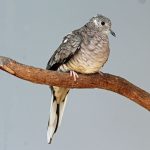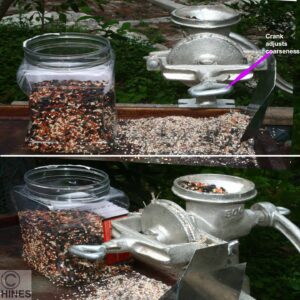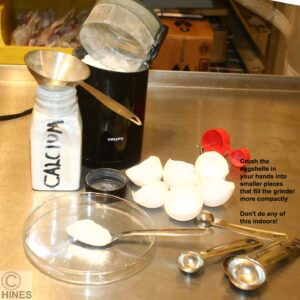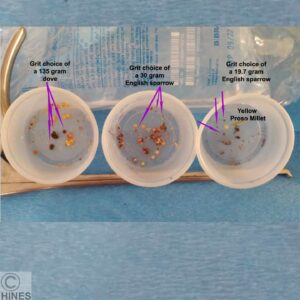What Can I Feed Orphan Baby Wild Doves & Pigeons?
Ron Hines DVM PhD
 All Of Dr. Hines’ Other Wildlife Rehab Articles
All Of Dr. Hines’ Other Wildlife Rehab Articles


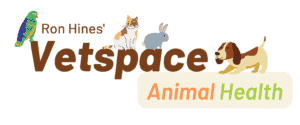
I love doves – their personality and their graceful beauty. Quite a few have come through my hands over the years. That has been primarily due to their poor nest building abilities. Once a few sticks have been carelessly crossed, doves and pigeons consider the job done.
Doves and pigeons are one of the few groups of birds that you are likely to encounter in the USA, Canada or Europe that require a very specialized diet. While other baby birds are simply present insects and perhaps some of their parent’s adult food by their parents, doves and pigeons (columbine birds) that are raising offspring transform their crop into a “milk” producing organ. Only flamingos, penguins and parrots do something similar. (read here)
Lest you take the word “milk” literally, cow or goat milk is NOT a suitable food for doves or pigeons because they both contain too much lactose sugar (milk sugar) that doves and pigeons cannot digest. This sugar ferments in their digestive tracts causing bloat, diarrhea and respiratory distress that eventually leads to their death.
The percentage constituents of dove milk are unknown. But pigeon milk, which is likely to be very similar, is about 70% water. Of the remaining solids in it, about 53-58% is protein and 34-35% is fat. Very little carbohydrates (including sugars) are present. The actual percentages of the contents of the milks of all species of animals never remains constant. It varies over time. Factors like the time of day, the diet consumed by the parents, the number of offspring being fed and the current age of the offspring all factor into its composition. Luckily, the infant animals of all species have been given the flexibility to deal with these variations. Of course, natural pigeon/dove milk also contains all the essential vitamins and trace minerals that the babies require. As the baby doves or pigeons mature, partially digested grains are regurgitated into this mix as well.
If you have occasion to raise orphan doves or pigeons, there are many recipes that have raised them quite successfully. For fat content, many recipes contain Nutrical® and/or olive or vegetable oils. For protein some contain peas, hemp powder, or vegan soy products. Varying amounts of one or another human or animal vitamin supplement as well as digestive enzymes are often thrown in the pot for good measure. A pinch of this, a smidgen of that – God bless Nature for being so flexible.
One commonly used recipe is called MAC Milk:
Many have found that commercial parrot-raising formulas like Exact® work quite well for doves. Others in Europe use the Psittacus Catalonia Wildiet® formula.
 My Technique:
My Technique:
Every year I feed out baby doves and pigeons with a recipe I have prepared at home for many years. I chose the ingredients based on what I know about avian nutrition, on products that are are safe, economical and readily available to almost anyone on short notice. This formula has worked well for me and I hope it will work well for you too:
This oversize coffee cup of mine comfortably holds 1.5 measuring cups of coffee:
1) Pour 1.25 measuring cups of dry instant oatmeal into the empty cup.
2) To the oatmeal, add 1 cup of shaken Silk® unsweetened organic soy milk that has been microwaved for 30 seconds. Unsweetened, non-flavored Silk® milk adds protein and, as importantly, calcium.
3) Mix them together well with a spoon and microwave the mixture for 1 minute or as you would a cup of coffee.
4) Once the oatmeal and soy milk have cooled, add the contents of 2 large whole eggs and mix very well. Never microwave once the eggs have been added because the mixture will become lumpy and unusable. Although raw eggs contain avidin which can inactivate a vitamin, biotin, this has never caused a problem for me when raising doves and pigeons. Dove eggs themselves contain avidin.
As the birds reach maturity, reduced the number of eggs used to one per cup. Oatmeal is deficient in Vitamin D3. Egg yolk is a good sources of vitamin D3 and the egg whites are an additional source of balanced protein.
5) Mix well with a spoon until homogeneous.
6) Top off to a comfortable height with Silk® soy milk. Silk® soy milk has a short refrigerator shelf life. When I have only a few doves to feed, I freeze the soy milk in smaller pouches and thaw them as needed.
Let the finished mix sit in your refrigerator for an hour or so until it become smooth and creamy and all small lumps have dissolved. Add a bit more soy milk if it is still too thick or if the babies are very young or if you suspect that they are mildly dehydrated as many fall-from the nest youngsters are. (read here) During the first week, the formula should drip from a syringe. As they get older, you can feed the formula thicker.
Bring your formula to room temp before feeding.
After feeding, the cup goes on the upper shelf of your refrigerator until it is time to bring it to room temperature again for another feeding.
I prepare no more than I will use up over a 48-hour period.
The most common cause of crop burn-throughs is feeding formulas that have been unevenly microwaved and contain hot spots. So, I always stir well after microwaving and after that, place a dab on my wrist to be sure the temperature is safe.
This mixture can be fed to baby doves and pigeons in many ways. I place it in a disposable pipette like the one above which is also seen in view in the topmost photo layouts. With this pipette, I place a bit of formula within the baby’s mouth with the bird allowed to swallow until its crop is moderately full. But never so overfilled and tight that it extends up the neck. If placing your finger against the bird’s neck causes regurgitation, you have given considerably too much at one feeding. Many smaller feeding, spaced throughout the day are always much safer than larger, infrequent feeding. Babies during their first week of life get fed four to five times. That is gradually reduced to three feeding and then to two. When the crop is empty and a little dent has formed at the collar, it is time to feed again. If the crop does not empty completely, you have not waited long enough or there is a health issue. After sundown, there is no need to feed.
Because I usually have a lot of mouths to feed and because baby birds can be messy, I often feed this formula to doves and pigeons using a 3ml disposable syringe and a catheter (tube feed). I cultivate contacts at local hospital supply departments and ask that intravenous catheter extension sets that have passed their FDA-mandated expiration date be set aside for me.
This is what they look like (you can enlarge all my images). You can see one laying next to the scissors in the third photo – before I have cut it to length and another already placed down the squab’s throat. Once your second finger feels the end of the catheter where the bird’s neck enters its body, slowly express the majority of the formula. As I slowly withdraw the catheter, I leave a teaser amount of formula near the rear of the bird’s mouth, so it gets some taste, pleasure and satisfaction out of the procedure. Over the 50+ years I have been tubing baby birds, I do not recall a single case where the tube entered the windpipe rather than the esophagus. Baby birds have a very strong reflex when they gape or feel food in their mouth that locks their larynx shut. So, a gently inserted tube going down wrong is quite unlikely. Nevertheless, watch an experienced aviculturist or wild bird rehabber tube feed before attempting to do so unassisted.
Temperature
Infant doves are very susceptible to digestive problems and slow crop emptying if they are kept at the wrong temperature. The white wing doves in the photo above are about two and a half days old. The larger one weighs 27.6 g the smaller one 25.0 g. At that age, their crop emptying time was best when they were maintained at 32 C (89.6 F) with a 100 watt incandescent bulb. At that temperature, these two dovlings took 75-80 breaths per minute. They began to pant and were hot to the touch when their surrounding temperature reached 37 C (98.6 F).
Those Were Some Of Your Dos What Are Some Of Your Don’ts?
Don’t put pressure on the full or partially full crop or the bird might regurgitate and inhale formula.
Don’t attempt to pass a catheter or pipette unless the bird’s head is in a star gazing position and the neck extended.
Don’t ever attempt to force a catheter or pipette downward that does not pass effortlessly.
Don’t ever attempt to feed a bird that is not bright and alert. They need subcutaneously administered fluids and glucose. You can read about that here.
Don’t neglect good sanitation. If it would not pass a health inspector’s muster in a restaurant setting, it’s not a fit in a bird kitchen either.
Don’t develop the habit of always feeding the dove or pigeon from the same side. That predisposes birds to developing scissor beak – a situation where the upper and lower beaks are misaligned. You can enlarge this photo of a hand-fed nightjar that developed this problem:
South Texas summers are quite hot and many of these infants are brought to me from far away. Most are dehydrated. After windy storms that blow them out of their nests and drench them, many are chilled despite the hot weather. Neither dehydrated babies nor chilled babies absorb nutrients well. In those babies, the natural wave like motion (peristalsis) that propels food down their digestive systems function poorly or not at all. Tube feeding babies suffering that condition actually speeds their demise because the formula just putrefies and ferments in their crop. As I already mentioned, markedly dehydrated babies need subcutaneous and intramuscular fluids. (read here) Mildly dehydrated babies need their first few feedings to be no more than warmed lactated ringers solution (LRS). They also need supplemental warmth if they are chilled. All wild creatures are masters at concealing stress, weakness and illness – until the very end. If the circumstances favor dehydration or chilling, just assume they are so, even if it is not outwardly apparent.
Once only small tufts of down remain on the head, I begin to place dishes of water and seed grains in the bird’s enclosures. A small rock (or marbles) placed in the water dishes (as seen in the second photo) help keep the birds from turning the water containers over when they perch on them. Since I give them no gravel to line their gizzards (gizzard gravel) at this age, I grind the grain mixture before I offer it to them. You can see the grinder I use in the photo above.
Be sure they are accepting mixed grains before you release them. A quality seed mix suggested for wild songbirds is fine. I add about a quarter amount of game bird (or turkey) starter crumbles to the mix. When whole seeds and grains are offered, I mix a bit of fine stone grit in with their food. The Hartz Gravel’n Grit™ is much too fine and goes right through them. So using well-washed masonry pea gravel from a building supply or river, I first remove the finer sand with a kitchen sieve. Then I remove the larger stones with a kitchen colander (with ~3/16″ holes). Then I wash and re-wash what is left and let it dry. Ground poultry oyster shell sifted in the same way works just as well and provides the birds an additional source of calcium. There is an inset image top right in the 4th photo at the top of this page of the proper size grit for a pigeon. The bird in that photo is already beginning to peck at whole grain.
My wife and I sometimes delay our release of doves beyond what my State allows. We don’t release late summer babies close to the Texas dove hunting season. Others that stay longer are birds that face medical issues and need care. In both cases, I find it wise to supplement a grain-based/seed diet with a small amount of ground dog chow prepared with the meat grinder as seen in the photo.
 Why Do You Use A Human Grade Oatmeal-Based Diet?
Why Do You Use A Human Grade Oatmeal-Based Diet?
Of all the cereal grains, whole rolled oats are among the most nutritious. It is considerably more so than corn or wheat. Instant baby oatmeal also blends readily with warm water. And because oats are practically gluten-free, the formula is not as sticky as one based on wheat would be. The brand of instant oatmeal that I purchase is pre-fortified with vitamins and calcium that the all infants including doves and pigeons need. Because this product is marketed for children, liability issues dictate that the ingredients be of top quality. Products intended for human consumption are considerably more rigorously monitored for quality than diets intended for animals. For example, the FDA and USDA spend 24 times as much money regulating human versus animal food. Name brand producers like Gerber have the wherewithal to do in depth analyses of their products -batch by batch. That is something that small niche pet food manufacturers generally do not have.
You will see two brands of baby oatmeal cereal in the second photo at the top. At one time I purchased Parent’s Choice™ because I noticed that it was all whole grain oat flour whereas the Gerber’s was only partially whole grain oat flour. I suppose because of that, the protein content of the Parent’s Choice was listed as significantly higher. But I cannot say that I noticed any difference in how the doves grew up eating one versus the other.
 Why Do You Add Raw Eggs To Your Diet?
Why Do You Add Raw Eggs To Your Diet?
1) Egg increase the formula’s fat/energy as well as its protein content
2) Raw egg albumin (the egg white) also makes my mix very “syringable”. Lumpy diets are hard to force through a standard syringe. The lecithin and albumin in eggs is also an excellent lubricant – so I do not need to use products like KY jelly on the syringe catheter when I am using one. I don’t feed soaked dog or cat chow to doves or pigeons. But when I soak and blend dry kibble to feed or tube other types of wildlife, I have to ream out the tip of the syringe with an 1/8” drill bit held in a vice-grip™ in order to get the slurry to pass through the tip freely.
3) Like natural pigeon milk, raw eggs contain important vitamins and antioxidants.
4) One of the most important thing that raw eggs contribute and that is lost in heating and cooking are protective antibodies. Most of these egg antibodies are called IgY antibodies. They are found primarily in the egg’s yolk. Although the chick was meant to absorb these antibodies from its yolk before hatching they remain protective in the intestine even when furnished after hatching. These antibodies are not only effective in controlling intestinal bacteria, they are also though to control the growth of C. albicans, the cause of avian thrush or candidiasis. Powdered egg will not do. Its antibodies were lost in processing.
Once the pigeon or dove hatches, these antibodies – which are also present in the parent’s natural crop milk are still important. But after birth the antibodies are thought to only have the ability to act locally within the squabs intestinal tract. Their molecules are too large to pass through the squab’s intestinal lining intact. Their presence there is still quite beneficial. It is not only the egg yolk that contains protective qualities – the whites do too (lysozymes).
 Well, isn’t there a danger in feeding raw eggs?
Well, isn’t there a danger in feeding raw eggs?
Yes, but the risk is small. One out of 10 – 20,000 commercially produced eggs in the United States tests positive for salmonella. That risk can, perhaps be reduced even further by buying free-range chicken eggs. (read here)
Pasteurized, whole egg are perhaps another option. But I do not know if IgY antibodies survive the pasteurization processes used. If that processed did not take the egg contents to over 60 degrees C (140 F) for ten minutes, these antibodies should have survived intact. (read here) I am still waiting to hear back from Davidson they never answered my email.
What About The Lack of vitamin A In Eggs and Oats?
It is true that you will not find any vitamin A listed on oat cereal labels and a single large egg has only about one tenth a human’s suggested daily vitamin A intake. But both egg yolk and oatmeal are rich in carotenoids that avian bodies have the ability to convert into active vitamin A (retinol). (read here) A source of either vitamin A or carotenoids are very important in maintaining a strong defense against infections and maintaining healthy skin and feathers.
Although some egg producers darken their egg yolks with artificial feed additives, more often darker orange/yellow yolks are a sign of higher carotenoid content. When given the opportunity, pick eggs with the deepest orange yolks. It is always safer to provide carotenoids than it is to supplement with vitamin A from things like cod liver oil or bird vitamin tonics. That is because too much vitamin A is toxic. (read here)
What Are Feather Stress Bars?
During the period that a bird’s feather is forming under its skin, the follicle that is producing the feather relies on a steady stream of protein building blocks obtained from the bird’s blood stream (the amino acids needed to build feathers including β-keratin). If that steady flow of amino acids are interrupted – by a lack of appropriate food, a disinclination to eat or starvation – the feather will no longer develop normally because the bird can no longer produce the keratin proteins required to form the feather. When those nutrients again reach the proper level in its blood stream, feather development returns to normal. So, a careful examination of a bird’s feathers gives you a look back into its past. In this particular dove in the two photos above, I or one of my volunteers apparently missed a scheduled feeding while the feather I am pointing to was developing. That resulted in the narrow white line – like a scissor cut – present to the right of my finger. Each incident of low blood amino acids causes a discrete line. You can see that the integrity and strength of of the feather shaft was compromised at that point. With time, that feather will break at both points. You can view a more idealized image of stress bars here and read a bit more about the problem and feathers in general here.
 Is There Enough Calcium In The Diet You Use?
Is There Enough Calcium In The Diet You Use?
Some wildlife rehabilitators and aviculturists associate deformed legs and feet (such as in this deformed white Turkish dove) with insufficient calcium in the diet during their growth period. I have never seen bone or joint problems or flexible bones in pigeons, doves or parrots fed this formula, so I believe that its calcium content is adequate. 8 grams of oatmeal contains about 4 mg of calcium and a 100 gm chicken pullet requires about 130 mg of calcium per day. The soy milk I use is also calcium-fortified.
When twisted or bowed foot or leg problems occur, it is more likely that they were caused by too smooth or too flat a cage floor. When a baby bird stands on a floor that is basically flat, its toenails will begin to curve sideways and exert a small twisting force to the toes. With time, like a tree branch, the toes will twist to accommodate that force. Eventually, the pad of the foot will not rest flat against the floor either. Those sort of problems can be prevented by furnishing the infant with a slightly indented twig mat similar to the mat that forms the coarse floor of a dove’s natural nest. I use a shallow plastic dessert bowl to maintain my artificial nest’s shape. Paper towels or Kleenex™ will not do. They slip and slide. As the bird grows, twigs should always be available that exceed the diameter of the bird’s clenched toes. You can read more about the problem, spraddle leg here.
 Why Do The Wild Doves In This Article Have White On Their Wings?
Why Do The Wild Doves In This Article Have White On Their Wings?
I live in the tropical Rio Grande Valley of Texas. Although some mourning doves are brought to me, more often they are tropical white-winged doves or tiny Inca doves.
 If I Keep Doves Or Pigeons After They Would have Left Their Nest, Should I Give Them Grit?
If I Keep Doves Or Pigeons After They Would have Left Their Nest, Should I Give Them Grit?
No, not necessarily.
There is no need for you to provide insoluble grit if you run the bird’s diet through an old-fashioned corn grinder like the one in the photo above. Set the crank you see in the photo at its coarsest setting to accomplish the same thing that grit does in a dove’s gizzard. An alternative to soluble grit are a sprinkle of powdered eggshells. A coffee bean grinder, such as the one in the photo does that well. I do not release the wild doves I raise until after our fall dove hunting season ends. The unfortunate dove in the last photo obstructed on a piece of grit that was too large. That dove came in with a broken wing that I repaired. I was supplying insoluble grit half that size at the time. Perhaps that piece of grit was already consumed. Perhaps it was unintentionally left in its flight from a previous occupant. Once you release a dove, it will find the right size and amount of grit on its own. Read more about grit requirments in birds here.
Dear reader, Besides your donations, visitors to the products that Google and others display on my website help me defray the cost of keeping my articles on the Web – and you informed. As you know, sites like mine that intentionally use no AI, no SEO, and are not written to Sell You Things are getting harder and harder to find, Best wishes, Ron Hines

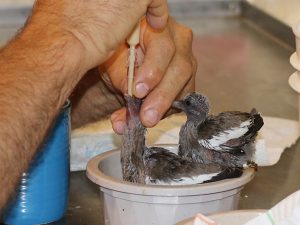
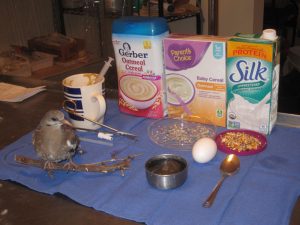

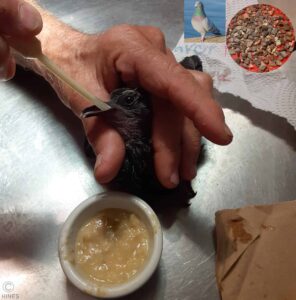
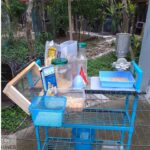
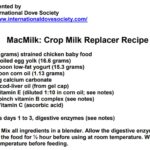
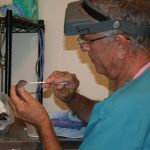 My Technique:
My Technique:
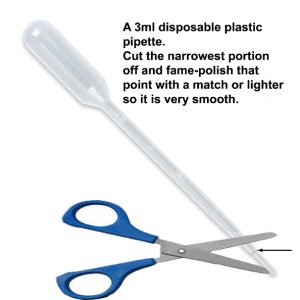

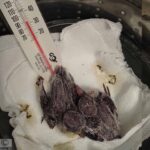
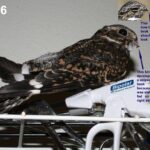
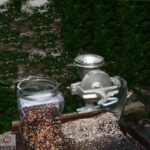
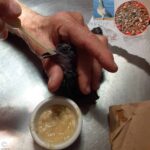
 Why Do You Use A Human Grade Oatmeal-Based Diet?
Why Do You Use A Human Grade Oatmeal-Based Diet? Why Do You Add Raw Eggs To Your Diet?
Why Do You Add Raw Eggs To Your Diet? Well, isn’t there a danger in feeding raw eggs?
Well, isn’t there a danger in feeding raw eggs?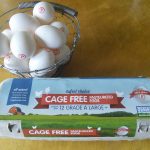
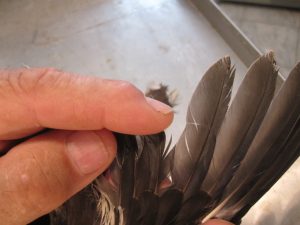
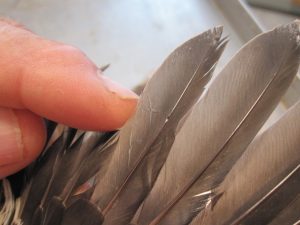
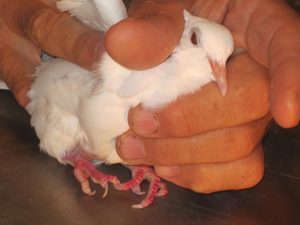
 Is There Enough Calcium In The Diet You Use?
Is There Enough Calcium In The Diet You Use? Why Do The Wild Doves In This Article Have White On Their Wings?
Why Do The Wild Doves In This Article Have White On Their Wings?